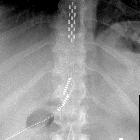medical devices in the thorax

RePneu®
Coils aus Nitinoldraht zur Behandlung des Lungenemphysems im Röntgenthorax p.a.

Röntgenbild
des Thorax in 2 Ebenen mit einem Carillon Mitral Contour System (Cardiac Dimensions) im Sinus coronarius. Dieses Nitinol-Device wird minimalinvasiv, katheterbasiert in den Sinus coronarius eingebracht und dort aufgespannt, um bei Mitralinsuffizienz so zu einer Annäherung der Klappenblätter zu führen und die Insuffizienz zu verringern. Zusätzlich sieht man noch einen Herzschrittmacher, eine künstliche Aortenklappe Sternalcerclagen und fraglich in der Seitprojektion einen Koronarstent.
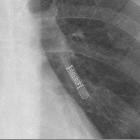



Tiefe
Hirnstimulation bei Morbus Parkinson: Hier die Aggregate im Bereich der Brust auf einer Röntgenaufnahme des Thorax.

Vorhofseptumdefekt
mit Verschlusssystem: Amplatzer-Device in Seitaufnahme besser zu sehen. Zusätzlich Kardiomegalie und pulmonale Hypertonie.
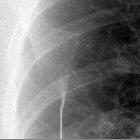
Defibrillator-Elektrode
im Röntgenbild: Die elektrische Leitung spreitzt sich in der aufgeklebten Elektrode fächerförmig auf.

Operativ
eingebrachter Spezialclip (AtriClip) auf dem linken Herzohr zur Vermeidung von Embolien aus diesem. Das Röntgenbild (Ausschnitte: links pa, rechts seitlich) zeigt zusätzlich noch eine künstliche Aortenklappe.

Z. n. TAVI
mit transapikalem Zugang. Man erkennt das Verschlusssystem an der Herzspitze (überlagert von der Sonde des ICD-Systems). Apica ASC

Eventrecorder
im Röntgenbild. Daneben sind TAVI, ein coronarer Stent und die Sonde eines Einkammerschrittmachers abgebildet, was bedeutet, dass der Eventrecorder wohl als nicht störend belassen wurde.


Um den
Mageneingang implantiertes Antirefluxsystem (LINX) mit einem expandierbaren Ring magnetischer Elemente, der den Tonus des Sphinkters von aussen unterstützt. Röntgenbild a.p. und seitlich.

Kardialer
implantierter Eventrecorder: BioMonitor (Biotronic). Die beiden halbkugelförmig nach oben stehenden Stifte sind die aufnehmenden Elektroden. (Es gibt deutlich kleinere Modelle von Eventrecordern.)

Medical
devices in the thorax • MitraClips - Ganzer Fall bei Radiopaedia

Medical
devices in the thorax • Amplatz septal occluder for secundum ASD - Ganzer Fall bei Radiopaedia
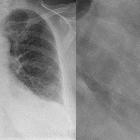
Herzohrverschluss
mit dem Amplatzer-System im Röntgenbild bei einer 69-jährigen. Röntgenbild pa und seitlich mit Vergrößerung.

Atrial septal
defect • Atrial septal defect closure device - Ganzer Fall bei Radiopaedia


Medical
devices in the thorax • Situs inversus and levo-transposition of the great arteries with cardiac pacemaker - Ganzer Fall bei Radiopaedia

Medical
devices in the thorax • Esophageal stent - Ganzer Fall bei Radiopaedia

Medical
devices in the thorax • Inspire device (radiographs) - Ganzer Fall bei Radiopaedia

Medical
devices in the thorax • Implantable cardioverter-defibrillator (ICD) - Ganzer Fall bei Radiopaedia

Medical
devices in the thorax • Artificial aortic and mitral valves - Ganzer Fall bei Radiopaedia

Medical
devices in the thorax • Amplatzer septal occluder - Ganzer Fall bei Radiopaedia

Vorhofseptumdefekt
mit Verschlusssystem: Amplatzer-Device in Seitaufnahme besser zu sehen. Zusätzlich Kardiomegalie und pulmonale Hypertonie.

Medical
devices in the thorax • Intra-aortic balloon pump - Ganzer Fall bei Radiopaedia

Medical
devices in the thorax • Endobronchial coils - Ganzer Fall bei Radiopaedia

Medical
devices in the thorax • Deep brain stimulator pulse generator - Ganzer Fall bei Radiopaedia

Breast
implants • Breast implants - Ganzer Fall bei Radiopaedia

Herzohrverschluss
mit dem Amplatzer-System im Röntgenbild bei einer 69-jährigen. Röntgenbild pa und seitlich.

Röntgenbild
des Thorax mit implantiertem links ventrikulärem Assistenz-Implantat (LVAD). Zusätzlich ist noch eine ICD vorhanden.

Medical
devices in the thorax • Epicardial pacing wires - Ganzer Fall bei Radiopaedia

Medical
devices in the thorax • ASD closure device - Ganzer Fall bei Radiopaedia



Medical
devices in the thorax • Atrial septal defect closure device - Ganzer Fall bei Radiopaedia

Medical
devices in the thorax • Chest wall repair - Ganzer Fall bei Radiopaedia


Röntgenbild
des Thorax in 2 Ebenen mit einem Carillon Mitral Contour System (Cardiac Dimensions) im Sinus coronarius. Dieses Nitinol-Device wird minimalinvasiv, katheterbasiert in den Sinus coronarius eingebracht und dort aufgespannt, um bei Mitralinsuffizienz so zu einer Annäherung der Klappenblätter zu führen und die Insuffizienz zu verringern. Zusätzlich sieht man noch einen Herzschrittmacher, eine künstliche Aortenklappe Sternalcerclagen und fraglich in der Seitprojektion einen Koronarstent.

AAI-Schrittmacher:
Sondenspitze in Projektion auf den rechten Vorhof. (Atrium, Atrium, Inhibition)



Medical
devices in the thorax • Cardiac event recorder - Ganzer Fall bei Radiopaedia

Medical
devices in the thorax • Pulmonary arteriovenous malformations - Ganzer Fall bei Radiopaedia

Operativ
eingebrachter Spezialclip (AtriClip) auf dem linken Herzohr zur Vermeidung von Embolien aus diesem. Computertomographie coronar rekonstruiert.



Medical
devices in the thorax • Congenital pulmonary valve stenosis - Ganzer Fall bei Radiopaedia


Medical
devices in the thorax • Biventricular cardiac pacemaker - Ganzer Fall bei Radiopaedia

Aggregat
einer tiefen Hirnstimulation bei Morbus Parkinson im Röntgenbild des Thorax.

Patent ductus
arteriosus • Patent ductus arteriosus closure device - Ganzer Fall bei Radiopaedia


Medical
devices in the thorax • pH probe - Ganzer Fall bei Radiopaedia

Medical
devices in the thorax • Wearable automatic external defibrillator - Ganzer Fall bei Radiopaedia

Medical
devices in the thorax • Scoliosis correction clip - Ganzer Fall bei Radiopaedia

Medical
devices in the thorax • 24 hour ambulatory impedance pH test - Ganzer Fall bei Radiopaedia

Medical
devices in the thorax • Left ventricular assist device (LVAD) - Ganzer Fall bei Radiopaedia

Breast
implants • Breast implants - MRI - Ganzer Fall bei Radiopaedia

Medical
devices in the thorax • Displaced pacing lead - Ganzer Fall bei Radiopaedia

Medical
devices in the thorax • Chest port on chest x-ray - Ganzer Fall bei Radiopaedia

Medical
devices in the thorax • Flail chest with subsequent internal fixation of rib fractures - Ganzer Fall bei Radiopaedia

Medical
devices in the thorax • Cooling blanket - Ganzer Fall bei Radiopaedia

Medical
devices in the thorax • Temperature probe on chest x-ray - Ganzer Fall bei Radiopaedia

Medical
devices in the thorax • Epicardial patch device - Ganzer Fall bei Radiopaedia

Medical
devices in the thorax • Plombage (lucite spheres) - Ganzer Fall bei Radiopaedia

Gunshot
injuries • Heimlich valve and hemopneumothorax - Ganzer Fall bei Radiopaedia

Medical
devices in the thorax • Antibiotic spacer (right shoulder) - Ganzer Fall bei Radiopaedia

Medical
devices in the thorax • Left atrial appendage occlusion device - Ganzer Fall bei Radiopaedia

Medical
devices in the thorax • Presternal peritoneal dialysis catheter - Ganzer Fall bei Radiopaedia

Medical
devices in the thorax • Impella left ventricular assist device - Ganzer Fall bei Radiopaedia

Medical
devices in the thorax • Pulmonary artery stents for stenosis post bilateral lung transplant - Ganzer Fall bei Radiopaedia

Medical
devices in the thorax • Lung volume reduction coils - Ganzer Fall bei Radiopaedia

Medical
devices in the thorax • Armoured endotracheal tube - Ganzer Fall bei Radiopaedia

Medical
devices in the thorax • Passy-Muir valve - Ganzer Fall bei Radiopaedia
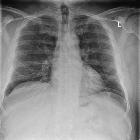
Medical
devices in the thorax • Wireless pH probe - Ganzer Fall bei Radiopaedia

Medical
devices in the thorax • Enhancing left atrial thrombus - Ganzer Fall bei Radiopaedia


Medical
devices in the thorax • Esophageal manometer - Ganzer Fall bei Radiopaedia

Medical
devices in the thorax • Breast tissue expander implants - Ganzer Fall bei Radiopaedia

Medical
devices in the thorax • Infusothorax-chemothorax - Ganzer Fall bei Radiopaedia

Medical
devices in the thorax • Pericardiocentesis catheter in situ - Ganzer Fall bei Radiopaedia

Medical
devices in the thorax • Chest x-ray implants and catheters - parachute device - Ganzer Fall bei Radiopaedia

Medical
devices in the thorax • Bronchial endovalves - Ganzer Fall bei Radiopaedia

Medical
devices in the thorax • Zio Patch - Ganzer Fall bei Radiopaedia

Medical
devices in the thorax • Left ventricular assist device - Ganzer Fall bei Radiopaedia

Medical
devices in the thorax • Venovenous ECMO - Ganzer Fall bei Radiopaedia

Medical
devices in the thorax • Dobhoff (nasogastric tube) tube - Ganzer Fall bei Radiopaedia

Breast
implants • Expandable breast implant - Ganzer Fall bei Radiopaedia

Medical
devices in the thorax • Watchman device - Ganzer Fall bei Radiopaedia

Medical
devices in the thorax • Minnesota tube - Ganzer Fall bei Radiopaedia

Medical
devices in the thorax • Fish Glassman viscera retainer - Ganzer Fall bei Radiopaedia

Medical
devices in the thorax • Pectus excavatum treated with NUSS bar - Ganzer Fall bei Radiopaedia

Medical
devices in the thorax • Patent ductus arteriosus closure device - Ganzer Fall bei Radiopaedia

Medical
devices in the thorax • CardioMEMS device - Ganzer Fall bei Radiopaedia

Medical
devices in the thorax • Double lumen cannula for VV ECMO - Ganzer Fall bei Radiopaedia

Medical
devices in the thorax • Endobronchial valves for emphysema - Ganzer Fall bei Radiopaedia

Medical
devices in the thorax • Sengstaken-Blakemore tube - Ganzer Fall bei Radiopaedia

Medical
devices in the thorax • Sleep apnea device - Ganzer Fall bei Radiopaedia

Medical
devices in the thorax • Bilateral phrenic nerve stimulators - Ganzer Fall bei Radiopaedia
Medical devices in the thorax are regularly observed by radiologists when reviewing radiographs and CTs.
Extrathoracic devices
- tubing, clamps, syringes, scissors, lying on or under the patient
- rubber sheets, foam mattresses, clothing, hair braids, nipple piercings, etc. may also be visible
These devices are a common cause of artifacts and may trip the unwary, but in general are recognized for what they are.
The following are more important to be recognized by the radiologist:
- oxygen masks and ventilator support tubing
- temperature and humidity sensor attachments
- ECG electrodes/leads
- external pacemaker-defibrillator (typically seen in a cardiac patient transported by helicopter or ambulance)
- bioreactance leads (e.g. Cheetah Starling SV sensors)
- breast prostheses
- breast tissue expander (used for breast reconstruction)
- cooling blanket
- presternal peritoneal dialysis catheter
Pleural devices
- thoracostomy tubes
- usually placed anterosuperiorly to drain pneumothorax, and posteroinferiorly to drain pleural effusion
- a well-positioned tube should lie between visceral and parietal pleura, and there should not be any kinking
- to check the correct positioning, frequently AP and lateral views are required. Supplemental CT scan may also be performed.
- should not enter the interlobar fissure, else it may be blocked ; tip should not be within the lung parenchyma or subcutaneous tissue
- all drain holes should be in the pleural cavity to ensure effective drainage
- pigtail catheter: used in empyema drainage
- Heimlich valve: it is a one-way valve used for pleural space drainages, which prevents the return of gases or fluids into the pleural space
- plombage: "ping-pong ball" plombage and wax plombage (historically used for tuberculosis, but no longer)
Tracheal, bronchial and esophageal devices
- endotracheal tube
- tip of the tube should be 5 cm +/- 2 cm above the carina (carina is just caudad to the aortic arch, if not clearly visible)
- may wrongly enter right main bronchus, esophagus or even the soft tissues of the neck
- sometimes, a deliberate double-lumen ET tube is used to check differential ventilation of the two lungs
- nasogastric/nasoenteric tube/feeding tube / Dobhoff tube
- esophageal balloons (e.g. Sengstaken-Blakemore tube, Minnesota tube)
- esophageal Doppler probe
- esophageal stents
- esophageal manometer
- esophageal pH probe (seen just above gastro-esophageal junction)
- temperature probe (usually within the oropharynx or esophagus)
- tracheostomy tube
- tracheo-esophageal voice prosthesis
- bronchial stents / tracheobronchial stents (in lung transplant patients or due to obstructing tumors)
- Passy-Muir valve
- endobronchial coils
- endobronchial valves
Vascular devices
- dialysis catheters
- peripherally inserted central catheters (PICC): central portion only
- central venous catheters: central tip ideally positioned at the superior cavoatrial junction and should not enter the right atrium
- temporary non-tunnelled lines: internal jugular and subclavian lines
- tunnelled lines: e.g. Hickman line, Broviac line
- permanent, implantable access line with subcutaneous ports: e.g. Port-A-Cath, Infus-a-Port
- pulmonary artery catheter (Swan-Ganz catheter)
- left atrial catheter
- right atrial line often used postpaediatric cardiac surgery
- thoracic aortic stent
- superior vena caval stent
- superior vena caval filter
- carotid artery clamps
- cannulas of extracorporeal membrane oxygenation devices
- in the right jugular vein (in case of peripheral cannulation), rarely in the left jugular vein
- in case of central cannulation both cannulas are placed directly via central vessels into the atria
Cardiac devices
- sternal wires, plates
- cardiac prosthetic valves, C-ring annuloplasty
- cardiac conduction devices
- pacemakers (e.g. biventricular pacemaker)
- implantable cardiac defibrillators (ICD)
- coronary stents
- circulatory assist devices
- intra-aortic balloon pump (IABP)
- left ventricular assist device (LVAD) (e.g. TandemHeart percutaneous VAD)
- biventricular assist devices
- artificial heart (under development)
- temporary ventricular assist device
- atrial septal occlusion device (e.g. Amplatz closure device)
- left atrial appendage closure devices (e.g. Watchman device)
- epicardial patch
- parachute device
- cardiac restraint device
- insertable cardiac monitoring device (e.g. Reveal LINQ)
- implantable pulmonary artery pressure monitoring device (e.g. CardioMEMS)
Miscellaneous
- embolization coils
- antibiotic spacer
- pericardial drain
- insertable loop recorder
- vertebroplasty-related
- spinal rods, transpedicular screws, disc spacers, interspinous spacers
- gastric band
- reflux management system
- diaphragmatic pacemaker
- surgical clips (e.g. axillary nodal clearance)
- Nuss bar (repair of pectus excavatum)
See also
Siehe auch:
- Fremdmaterial im Röntgenbild des Thorax
- Fremdmaterial Thorax Herz
- Eventrecorder
- Herzohr Okkluder
- Herzschrittmacher
- Mitraclips
- Carillon Mitral Contour System (Cardiac Dimensions)
- Artefakte im Röntgenbild des Thorax
- Intraaortale Ballonpumpe
- intrakardialer Herzschrittmacher
- left ventricular assist device (LVAD)
- Plombage
- Ösophagusstents
- Vertebroplastie
- Verschlusssystem apikaler Zugang bei TAVI
- Kontraindikationen für eine MR-Untersuchung
- abdominelle Implantate
- EKG-Elektroden
- Antirefluxsysteme
- Defibrillator Pads aufklebbare
- Rückenmarkstimulation
- Vagusnervstimulator
- EKG-Kabel
- abdominelle Implantate und Devices
- Deep brain stimulators
- Koronarstent im Röntgenthorax
- Defibrillator Thorax
- pacemakers
und weiter:
- transcatheter aortic valve implantation (TAVI)
- BH im Röntgenbild
- Herzohr Clip
- septal occluder
- left ventricular assist device
- thorakale Plombage
- Okkluder
- Artefakte im Röntgenbild
- MRT unmittelbar postoperativ
- Clip Thorax Herz
- biologische Aortenklappe
- Instrumentenkabel
- RePneu Lung Volume Reduction Coil
- endoskopische Lungenvolumenreduktion
- Implantate
- tragbarer (wearable) Defibrillator

 Assoziationen und Differentialdiagnosen zu thorakale Implantate / Devices:
Assoziationen und Differentialdiagnosen zu thorakale Implantate / Devices:Artefakte im
Röntgenbild des Thorax
